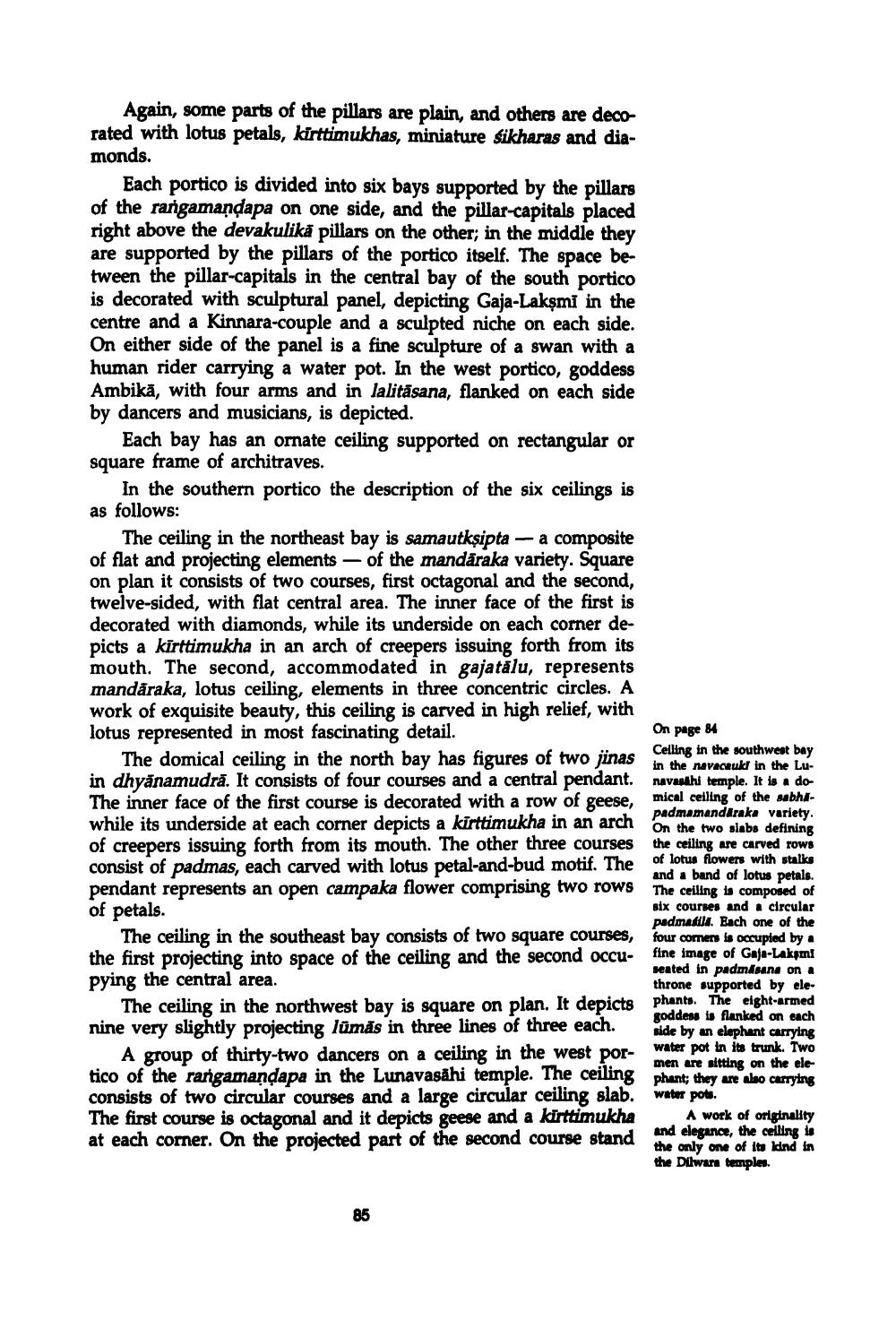________________
Again, some parts of the pillars are plain, and others are decorated with lotus petals, kirttimukhas, miniature sikharas and diamonds.
Each portico is divided into six bays supported by the pillars of the rangamandapa on one side, and the pillar-capitals placed right above the devakulikä pillars on the other; in the middle they are supported by the pillars of the portico itself. The space between the pillar-capitals in the central bay of the south portico is decorated with sculptural panel, depicting Gaja-Lakṣmi in the centre and a Kinnara-couple and a sculpted niche on each side. On either side of the panel is a fine sculpture of a swan with a human rider carrying a water pot. In the west portico, goddess Ambika, with four arms and in lalitasana, flanked on each side by dancers and musicians, is depicted.
Each bay has an ornate ceiling supported on rectangular or square frame of architraves.
In the southern portico the description of the six ceilings is as follows:
The ceiling in the northeast bay is samautkṣipta - a composite of flat and projecting elements of the mandaraka variety. Square on plan it consists of two courses, first octagonal and the second, twelve-sided, with flat central area. The inner face of the first is decorated with diamonds, while its underside on each corner depicts a kirttimukha in an arch of creepers issuing forth from its mouth. The second, accommodated in gajatālu, represents mandāraka, lotus ceiling, elements in three concentric circles. A work of exquisite beauty, this ceiling is carved in high relief, with lotus represented in most fascinating detail.
On page 84
Celling in the southwest bay
in the navacauki in the Lunavasahi temple. It is a do
mical ceiling of the sabhäpadmamandaraka variety. On the two slabs defining the ceiling are carved rows of lotus flowers with stalks and a band of lotus petals. The ceiling is composed of six courses and a circular padmadila. Each one of the four corners is occupied by a fine image of Gaja-Laksmi seated in padmasana on a throne supported by ele
phants. The eight-armed
goddess is flanked on each side by an elephant carrying water pot in its trunk. Two men are sitting on the ele
water pots.
A group of thirty-two dancers on a ceiling in the west portico of the rangamanḍapa in the Lunavasahi temple. The ceiling phant; they are also carrying consists of two circular courses and a large circular ceiling slab. The first course is octagonal and it depicts geese and a kirttimukha at each corner. On the projected part of the second course stand and elegance, the celling is
A work of originality
the only one of its kind in the Dilwara temples.
The domical ceiling in the north bay has figures of two jinas in dhyanamudra. It consists of four courses and a central pendant. The inner face of the first course is decorated with a row of geese, while its underside at each corner depicts a kirttimukha in an arch of creepers issuing forth from its mouth. The other three courses consist of padmas, each carved with lotus petal-and-bud motif. The pendant represents an open campaka flower comprising two rows of petals.
The ceiling in the southeast bay consists of two square courses, the first projecting into space of the ceiling and the second occupying the central area.
The ceiling in the northwest bay is square on plan. It depicts nine very slightly projecting lumas in three lines of three each.
85




